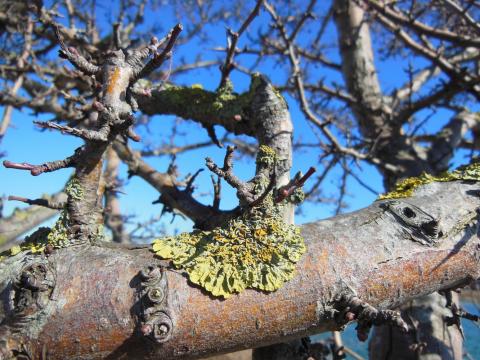Should I be worried about the lichens growing on the bark of my apple trees?

Although lichens are sometimes mistakenly thought to be a fungal disease, they are actually the combination of two different organisms. Fungal cells make up the main body and structure of each lichen, and algae or cyanobacteria give it its green or blue color. The fungal part of a lichen is not capable of creating its own food, thus it relies on the photosynthesis in the algae cells for the energy it needs to grow. In turn, the fungus provides the algae with water and minerals and prevents it from drying out. This mutually beneficial relationship is called symbiosis.
Lichens will grow on pretty much any firm, well-lit surface like the bark of trees. Lichens grow best when they are exposed to full sunlight, and dead or dying trees can be the perfect habitat. When the canopy of a tree thins for one reason or another, more light is allowed to reach the trunk and branches, creating an ideal environment for lichens to grow and proliferate. Since lichens are often found growing on the bark of trees that are in poor health, it is often assumed that they are to blame. However, the relationship between the lichens and the tree is largely benign, and the decline of the tree is the result of some other stressor. Even though a lichen can absorb some mineral nutrients from the surface it is growing on, it is primarily self-sufficient.
Trying to scrape lichens off of the bark will likely do more harm than good, and applying a fungicide will have absolutely no effect at all. Instead, focus on mitigating whichever factor is limiting the growth of the tree, such as poor growing conditions. Plant health often directly correlates to the characteristics of the soil. An improper pH, poor fertility, or unsuitable drainage will often stunt tree growth if not lead to overall deterioration. Trees that are routinely impacted by serious insect pest or disease issues are also at risk of decline. Frequently scouting for signs of damage from pests and promptly applying appropriate management strategies can help. If you decide to replace your lichen covered trees with new ones, make sure to address whichever issues limited the original plantings.
There is an upside of having lots of lichens on your trees. Lichens are extremely sensitive to air pollution and are only found growing in places with good air quality, explaining why you rarely see them growing along city streets. Rather than lament over the presence of lichens on your trees, appreciate their diversity and unique place in the natural world.
Got questions? The Ask UNH Extension Infoline offers practical help finding answers for your home, yard, and garden questions. Call toll free at 1-877-398-4769, Monday to Friday, 9 a.m. to 2 p.m., or e-mail us at answers@unh.edu.
Related Resource(s)
Do you love learning about stuff like this?
SUBSCRIBE TO Granite State Gardening newsletter
Got questions? The UNH Extension Yard and Garden Infoline offers practical help finding answers for your yard and garden questions.
Call toll free at 1-877-398-4769, Monday to Friday, 9 a.m. to 2 p.m., or fill out webform.
